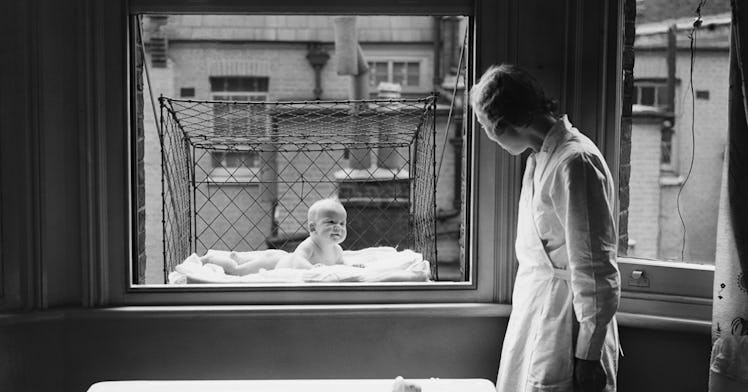The Weird History of Baby Cage, The Oddest Parenting Trend of the ’20s
In the early 1920s, baby cages popped up in space-cramped apartments. The coop-like cages let parents "air" out their babies without leaving their apartments.

In the dog days of summer, when the heat seems to settle on cities like a thick blanket, it’s hard to imagine how urban families of yesteryear beat the heat before air conditioners, refrigerators, and fans. Some of the methods seemed downright charming: In an essay he wrote about sweltering summers in Manhattan for The New Yorker, the playwright Arthur mentioned among other things, hopping on the back of a horse-drawn wagon to steal an ice chip or two to combat the heat and how wealthy families would escape to Central Park and camp out on the grassy lawns next to their big alarm clocks. Other methods were indescribably strange, and speak to the odd world of parenting advice that trafficked before true science emerged. One of the strangest, although it wasn’t limited only to summer, the idea of “airing out children” in baby cages above the window.
In the late 19th century, per Mental Floss, a parenting book written by Dr. Luther Emett recommended the process of “airing out children” to “renew and purify the blood.” The idea was that getting infants regular bursts of fresh air would theoretically build their immune systems and ward off common colds. In 1922, as a solution for people living in cramped apartments who still wanted to abide by airing, the baby cage was invented.
So, what, exactly was a baby cage? Well, it was a metal structure built into apartment windows that acted as an enclosed mini terrace of sorts. The fence-like cages resembled a chicken coop or modern-day air conditioner guard. But instead of holding a fowl or frigid-air pushing appliance they offered apartment-dwellers an area to place their babies. That’s right: Babies were placed in a cage hung out a window, above the street below, while parents attended to things in the house.
Let’s play devil’s advocate here. As long as it was secure, the cage sort of seems like a great solution for time- and space-strapped trendy parents? I mean, what’s the worst that could happen? A bird shits on the baby? Someone heckles it from the street below? If it wasn’t horribly cold outside, what’s wrong with fresh air? This was another time: It’s not like you had to worry about someone filming it and parent shaming you on social media.
It seems that early 20th century Londoners also adopted the baby cage trend, as this old newsreel shows:
And, as Chris Wild wrote for Mashable on the subject, the baby cage trend had some high-profile adopters in New York, including first lady Eleanor Roosevelt.
Eleanor Roosevelt, who by her own admission “knew absolutely nothing about handling or feeding a baby,” bought a chicken-wire cage after the birth of her daughter Anna. She hung it out the window of her New York City apartment and placed Anna inside for her naps — until a concerned neighbor threatened to report her to the authorities.”
The popularity of the baby cage declined after the 20s. But, in terms of long-ago parenting trends, it still acts as an emblem to one thing in particular: parents will try every weird contraption for the health of their baby, including a window cage. Is this so different from the monitors and swinging bassinets found in homes today? Well, yes. But in the future, our accessories and trends might be looked at as strange or outdated. Despite the differences, one truth persists: Parents love a good trend, no matter how weird.
This article was originally published on